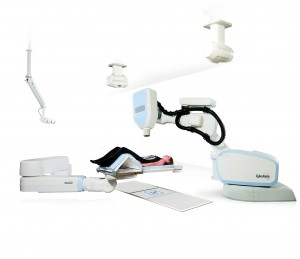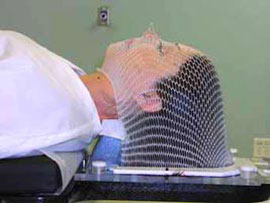At Phoenix CyberKnife Radiation & Oncology Center, we are proud to offer the most advanced technology available for treating tumors all throughout the body with the CyberKnife System. This radiation therapy delivers high doses of radiation to tumors while tracking the body’s natural movements in real time to minimize exposure to the healthy surrounding tissue. This process makes it an effective radiation treatment that reduces the risk of side effects for patients.
Lung CyberKnife Treatment

The CyberKnife System has been shown to be extremely effective at treating lung cancer, especially in its beginning stages. The CyberKnife System’s design is ideal for treating lung cancer, because tumors in the lung are constantly moving due to respiration. Unlike conventional radiotherapy, the CyberKnife System tracks lung tumors as they move in real time, targeting only the tumor and avoiding the healthy surrounding tissue. The CyberKnife System has been able to deliver a 95% survival rate to lung cancer patients 3 years post treatment, so long as tumors are in the operable stage.
The first step to the treatment is the placement of fiducial markers in order to highlight the tumor’s exact location before treatment. The fiducial markers (3 to 5 tiny gold seeds) are inserted through the chest and into the tumor and surrounding lung tissue using a small needle. The placement of the markers is guided by a CT scan, ultrasound, or a camera passed through the patient’s mouth. These markers help doctors create a treatment plan for administering the radiation to the tumor in a way that prevents damage to surrounding tissue.
Next, patients are fitted for a customized body cradle made to ensure that patients maintain the same body position for each recurring treatment. The cradle is designed using soft material and promotes the comfort of the patient throughout the treatment. While lying in the cradle, a CT scan is performed on the patient to locate the tumor and determine its size. An MRI might be necessary as well to get a proper visual of the tumor and the anatomy surrounding it. The patient is also fitted for a Synchrony vest that assists the CyberKnife robotics in following the tumor and correlating breathing patterns with the tumor’s movements.
Once the treatment plan has been developed by data found through the fiducial markers and imaging tests, the CyberKnife treatment is administered. Patients are secured in their custom body cradle wearing their Synchrony vest, they then lie relaxed on the treatment table as radiation is sent to the lung tumor.
Brain CyberKnife Treatment

The CyberKnife System allows doctors to effectively treat brain tumors in a highly advanced way using the latest radiotherapy technology. The CyberKnife System uses X-ray images that reference the uniquely bony structure of a patient’s head, and delivers radiation to the tumor with extreme accuracy and sub-millimeter precision.
The CyberKnife treatment eliminates the need for rigid, stereotactic frames that traditional radiology methods (such as the Gamma Knife) rely on when treating brain tumors. With the CyberKnife treatment, patients are fitted for a custom-made, mesh face mask. The mask is comfortable and non-invasive, and is made to help the patient keep their head and neck still during treatment. This mask is worn while the patient receives a CT scan, and perhaps an MRI, PET scan, or angiogram if necessary.
With brain tumors, the CyberKnife System may be used exclusively for treatment, or in addition to chemotherapy, surgery, or whole brain radiation therapy. Once a specific treatment plan has been determined, the CyberKnife System treatment begins. The patient lies on a table wearing their fitted, mesh mask. The CyberKnife System’s computer-controlled robot delivers radiation to the tumor, while the patient simply relaxes and remains still. Brain cancer treatments are typically completed within five days using the CyberKnife System.
Prostate CyberKnife Treatment
The prostate moves naturally when air passes through the rectum and as the bladder empties and fills. Fortunately, the CyberKnife System is specially equipped to deal with this challenge as it actively identifies the exact location of the prostate and adapts to every movement the prostate makes during treatment.
The CyberKnife System is often used exclusively for prostate tumors in the early stages, or in conjunction with external beam radiation if the cancer spreads beyond the prostate.
Prostate tumors require the placement of fiducial markers before CyberKnife treatment. With this procedure, 3 to 5 tiny gold seeds are inserted into the prostate using a small needle guided by an ultrasound machine. These markers are used to highlight the exact location of the prostate. Patients might be asked to clean out their rectum using an enema the day before the fiducial markers are placed.
A custom fit body cradle will be made for patients undergoing the CyberKnife treatment for prostate cancer. The cradle is designed to help patients lie comfortably still while receiving a CT scan and/or MRI. The CT scan and MRI data helps doctors determine the size of the area they must target with radiation while avoiding critical surrounding structures, such as the bladder and rectum.
When the CyberKnife treatment is administered, patients lie comfortably within the body cradle as the robotic system sends radiation directly to the prostate, constantly adapting to the natural movements of the prostate tumor. The treatment is typically completed within 1 to 5 short sessions over a span of 1 to 5 days.
Liver CyberKnife Treatment
Liver tumors present a problem for traditional radiotherapy treatments, because they move naturally with respiration. Additionally, the tissue surrounding liver tumors is especially sensitive and easily damaged. Fortunately, The CyberKnife System is able to compensate for these challenges by adapting to the movement of the liver tumor in real time and avoiding the surrounding tissue, while still effectively treating the tumor.
The first step in the treatment of liver tumors is the placement of fiducial markers (tiny gold seeds) in and around the tumor through the guidance of a CT scan, ultrasound, or a camera that is placed through the mouth and into the stomach and small intestine. These markers are used to identify the exact location and size of the tumor. The fiducial markers must be in place approximately one week before the CyberKnife radiation treatment is to begin.
The patient will be fitted for a custom body cradle that will help keep them comfortable and ensure consistent body positioning throughout multiple steps of the treatment process. The patient will also be fitted for a Synchrony vest, which enables the CyberKnife technology to precisely track the tumor’s motions as radiation is delivered, helping prevent any healthy surrounding tissue from being exposed to the radiation.
Before being given the radiation therapy, the patient will undergo CT image tests and possibly an MRI or PET-CT to help determine the tumor’s size, shape, location, and surrounding anatomy.
When the CyberKnife treatment is administered, patients wear their Synchrony vest and lie in their custom made body cradle on a treatment table. As the radiation is delivered, the robotic system will use digital images of the fiducial markers and information from the Synchrony vest to ensure radiation is delivered with sub-millimeter accuracy.
Doctors will monitor patient’s status through physical exams, blood tests, and imaging tests for the months and years following treatment.
Pancreas CyberKnife Treatment
Tumors in and around the pancreas present a problem for traditional radiation therapies because pancreatic tumors move with a patient’s breathing. This makes it difficult to deliver enough radiation necessary without damaging the healthy surrounding tissue.
Pancreatic CyberKnife treatment patients require the placement of fiducial markers in the pancreatic tumor, which are used as reference points during the CyberKnife treatment, and help ensure the exact location and size of the tumor before radiation is delivered. The fiducial markers are placed approximately one week before the treatment plan can be solidified.
Patients are fitted for a custom-made body cradle to be used during image testing and radiation treatment. Additionally, patients will be fitted for a Synchrony vest that allows the CyberKnife robotics to accurately track the tumor during testing and radiation treatment. Imaging tests such as CT scans and possibly an MRI scan will determine the size, shape, and location of the tumor, as well as the anatomy surrounding it.
When it is time for radiation treatment, the data generated by the image testing, as well as the design of the Synchrony vest, help the CyberKnife system to accurately track the tumor’s movements. The CyberKnife treatment can then deliver high-dose radiation straight to the tumor while constantly mirroring the tumor’s movements. This allows for highly effective treatment of the tumor while minimizing side effects.
The CyberKnife System usually treats pancreatic cancer in four to five sessions, and in under one week. The CyberKnife treatment has been shown to be effective and well-tolerated by patients without the risk of impairing pancreatic function.
For more information about how the CyberKnife System is used to treat a variety of cancers, including those listed above, be sure to contact us today.
